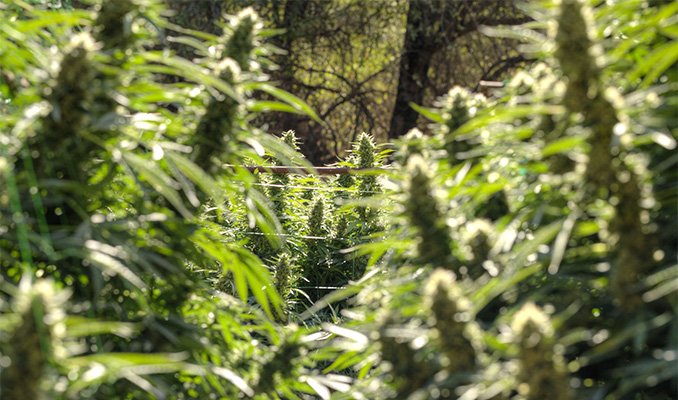The Process Behind Forced Flowering And Why You Should Do It
Published :
Feb 14, 2018
Categories :
Cannabis cultivation

Forced flowering could be an invaluable skill in your grower's repertoire. This is especially true if your outdoor growing area is prone to huge fluctuations in climatic conditions.
Growers may decide to cultivate cannabis outdoors for a number of reasons. If space is a limiting factor, then the great outdoors provides the perfect canvas to crop your cannabis. However, in this environment, your marijuana plants are at the mercy of Mother Nature. In some parts of the world, this can be favourable. However, some growers are subjected to seasons with variable temperatures and conditions, often making a successful natural harvest difficult. If left too long before harvesting, your cannabis buds can be plagued with a plethora of problems.
This is where “forced flowering” comes into play, effectively shortening the vegetative stage of your cannabis plants and encouraging them to flower early. If you live outside of moderate climate zones, then this approach could prove invaluable.
WHAT IS FORCED FLOWERING?
Cannabis plants typically don't start flowering until August/September. This is a result of the natural reduction in daylight hours. Cannabis plants will switch from the vegetative stage to the flowering stage when they start to receive 12 hours or more of uninterrupted darkness. Given that in the majority of northern European countries frost starts to set in around this time, a disaster for your crop could be just around the corner. Not to mention that rainy and humid conditions can cause your buds to mould.
Put simply, you are forcing your cannabis plants to sacrifice growth in order to enter the flowering stage early. This is to ensure they can still be harvested when the weather is favourable, returning a more plentiful and healthy haul.
WHY FORCE YOUR CANNABIS TO FLOWER?
By tricking your cannabis plants into flowering early, you can enhance the quality of your buds. All the daylight still prevalent in late July/August will now be focussed on bud production rather than plant growth. Richer, more potent buds can be harvested, all before any undesirable weather conditions start to set in. Increases in UV-B rays as a result of extra sunlight directly supports THC production. Maximising this window is vital.
With careful and strategic planning, forced flowering can enable outdoor growers to have multiple harvests. As many as 2-3 cycles a year. Clever planning means a grow started in the early spring can be forced to flower and ready for harvest in June, whilst another grow running alongside it could be ready in the autumn.

HOW TO FORCE THE FLOWERING STAGE
Now that we know forced flowering is an essential skill to learn for some growers, how do we actually initiate this stage of the cannabis life cycle?
The art to this lies in manipulating the hours of complete darkness that your cannabis plants receive. To kick-start this process, you need to develop a method of blocking out any sunlight. This is usually done by placing a large tarpaulin or cardboard box over the plants. Anything with a similar effect will work as long as the following two things occur.
The material you use needs to be completely opaque. Any rogue sunlight or light pollution (in urban areas) incurred overnight can freak your plants out, forcing them back into a vegetative state. The second most important thing to consider is the time period in which you restrict the sunlight. You want to maximise the quality of the sunlight to encourage bud production, but you still need to be regimented in the time the plants are covered and uncovered. Minimum of around 12 hours undisturbed darkness. Again, deviations in this timing can cause irreparable damage to your cannabis plants.
Maximising sunlight is dependant on the positioning of your plants. If they are in an area that receives plentiful warm evening sun, then you wouldn't want to cover them up at 5 in the afternoon. Likewise, leaving it too late would mean the plants miss out on sunlight in the morning. Whichever timespan you pick, just make sure you stick to it!
RISKS WHEN FORCING FLOWERING
The level of risk forced flowering incurs is dependent on how you have chosen to cover your plants. Cannabis plants need adequate air flow, not only to maintain cool temperatures, but to prevent mould build up. If the cover you are using is sat directly on top of the plants, this will stifle them, pushing the temperature up. This can be easily remedied in most situations by careful placement of a fan.
On a larger scale, growers may choose to grow in outdoor sheds. This enables them to maintain a healthy environment with good airflow, also allowing for regimented control of sunlight hours by simply covering any gaps where light could bleed through. The issue of sunlight control is so key; missing even a few days in the routine could completely break your plant's natural cycle.
Ultimately, as long as the growing area is planned out, you have a schedule for harvest, and a sufficient means of blocking sunlight, forced flowering is your ace in the hole. This is especially relevant when natural climates make productive outdoor cannabis growth difficult.






































